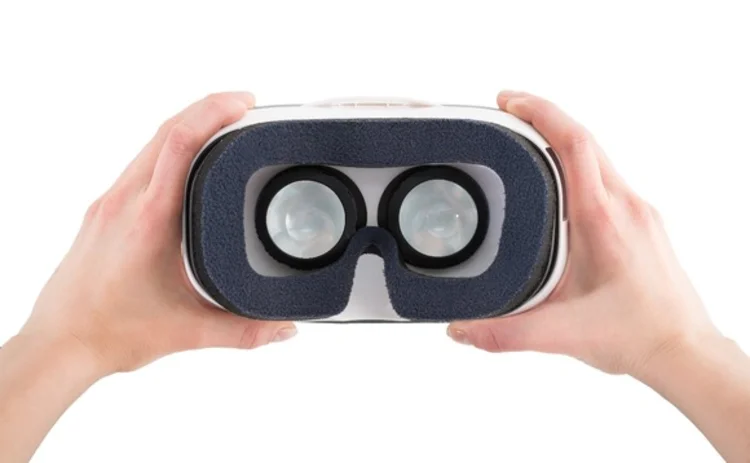The Reality of Virtual Reality: VR's Future in Financial Services
Financial services firms have started to show interest in use cases for virtual and augmented reality as the general public grows more accustomed to using the technology.

I’m walking on the moon, and to be honest, I’m not that impressed. Don’t get me wrong, it’s good. But I was expecting a bit more. You see the Earth once from 238,900 miles away, and you’ve seen it a million times.
That’s why I decided to switch things up and travel back to the Mesozoic Era. Jurassic Park was always one of my favorite movies as a kid. Why not check it out for myself? Dinosaurs prove to be a bit more intriguing, as the trip culminates with a Tyrannosaurus Rex dropping some food right at my feet, but it still leaves something to be desired. I want to do some exploring, and I can’t really move during these trips.
So I decide to journey to a haunted house. Finally, it seems, I’ve found what I’m looking for. Mice run over my feet as I walk around. Unoccupied chairs move spookily in front of a broken TV in a room I pass by. I am not watching someone walk through a haunted house — I am walking through a haunted house.
The only thing keeping me grounded in reality is a faint noise I hear in the background. It seems to get louder the more I ignore it. I finally decide to take off my earphones to find out what it is.
“Dan, what do you think? Pretty cool, right?” my girlfriend, Samantha, says to me, her eyes searching for approval and validation.
“I think it’s far more viable that you would go to an augmented reality-type solution when you’ve got someone sitting at a desktop or working in an environment that’s already got a complex set of workflows around than trying to move them into a pure virtual space.” Stuart Riley, Citi
Consumerization of VR
For those of you who weren’t able to follow along, my ability to travel through space, time and paranormal activity, all within a matter of minutes, was made possible thanks to a virtual reality (VR) headset my girlfriend received as a gift over the holidays. Now, just to be clear, this wasn’t some exclusive or expensive product. In fact, there is a good chance you or someone you know has already had a similar experience with this type of technology. The barrier for entry into the world of virtual reality has never been lower.
And while most people are quick to associate VR with some type of entertainment—whether it be movies, video games or some other form of media—the technology has real use cases in financial services. While not necessarily ready for mass adoption, virtual reality is nearing a tipping point, according to some. As consumers grow more accustomed to using the technology, they’ll soon expect to enjoy its benefits at work.
“I think it’s just a matter of time. There is this large movement going on where people are saying, ‘Look, I have this experience at home. I can talk to my Amazon Echo. I can put on a pair of VR lenses. I can click a single button and have something delivered to my house. But when I get to the office I have to open up 25 applications on my desktop, and it’s a nightmare. What am I doing?’” says a product manager at a large technology firm. “So you have this human–machine interaction at home, and then you get to the workplace—where you spend most of your time—and you’re years behind.”
Virtual vs. Augmented
Before going any further, it’s important to make a distinction between the different terminology used for VR. While one might be quick to use virtual reality as an all-encompassing label, there are two—or three, depending on whom you ask—distinct camps. VR is considered immersive technology that allows users to isolate themselves from the physical world (Oculus Rift). Augmented reality (AR) is overlaying a digital world in a physical space (Google Glass). Mixed reality (MR) is a combination of both VR and AR (Microsoft HoloLens), although some in the space consider it to be a different interpretation of AR.
The distinction is important, as many see AR as being far more practical for the industry than VR. Stuart Riley, global head of markets and securities services technology and operations at Citi, falls into that camp. Riley, whose team participated in an AR project aimed at futures traders, says traders’ desktops are too complicated to expect firms to duplicate all of their applications for a digital environment, which would be required for a true VR experience.
"If you move into an augmented reality, you can pull the bits that benefit from 3D visualization and you can leave the pieces that maybe don't or you haven't got the money or time to reengineer that are in the natural environment, and essentially just have the two side by side and actually develop the platform such that they can interoperate," Riley says. "I think it's far more viable that you would go down an augmented reality-type solution when you've got someone sitting at a desktop or working an environment that's already got a complex set of workflows around than trying to move them into a pure virtual space."
Point of Reference
A trader using AR could look to the left at a spreadsheet on their PC and then to the right and see a series of screens that are not connected to any physical space. The technology works off markers, with one center marker acting as the point of reference for the glasses and creating the field of vision, according to a technology vendor product manager (PM).
There is also the human interaction that constantly takes place on every trading floor to consider. Riley and the technology firm’s PM both say that’s a major reason why they don’t see VR catching on the way AR can at financial firms.
“VR is really immersive. On the trading floor I don’t know how well that would work. You’re basically isolating yourself from the physical world,” the PM says. “AR makes complete sense. You’re overlaying a digital world in a physical space.”
Not everyone is as willing to dismiss VR, though. Sean Belka, senior vice president and director of Fidelity Labs, the research and development arm of Fidelity Investments, doesn’t see it as such a black-and-white proposition. While he agrees that AR does seem like a good fit for financial services firms because of its ability to take multiple data sources and integrate them into a single experience, Belka, whose team has worked on both AR and VR projects, says it’s too early to pick a winner.
“I don’t think we’re going to be declarative about which is better for the enterprise, or which is better for consumers. Our goal is to broadly experiment and learn and iterate. So we’ll continue to do both AR and VR experiments in both the enterprise and the consumer environment,” Belka says. “It may shake out at some point one way or the other, but from our point of view, we’re still in the experimentation phase and we’re going to explore broadly.”
Front-Office Fun
Regardless of whether you’re a proponent of VR, AR or both, you’d be hard-pressed to find actual implementations of the technology at financial firms. That’s not to say firms aren’t actively investigating its benefits via experiments.
The trading floor is where most look first when it comes to practical implementations. AR technology can provide great benefits to traders if executed properly, according to the tech firm’s PM.
“You could go to a trader and say, ‘You can process more information, or the right information, at the right time; you can switch context in real time and you can do less with more.’ You can almost figure out whether you could get five more trades done a day. How much do you make on average per trade? Can you get to trade idea quicker? Can you understand what’s going on in the larger market because you have some 3D visualization that’s in your periphery? Or does the right information come in at the right time based on some rule set?” the PM says. “If you get that right, then the cost is not even a question for the trader.”
That was part of the idea around an AR project Citi participated in last year. The bank partnered with 8ninths, a VR/MR software company that was a member of the Microsoft HoloLens Agency Readiness Program, which provides vendors with the opportunity to build out use cases for potential clients using the Microsoft HoloLens. Specifically, the group set its target on the futures market due to the vast amount of data in the space, according to Citi’s Riley.
The result was the “Holographic Workstation,” a combination of a 2D and 3D work environment for traders to visualize market data and share it with their buy-side counterparts.
“We felt that data visualization, specifically financial data, was a use case where any edge that you can get on the competition is perceived as extremely high-value. We could help a trader make a deduction that would typically take them longer to process, or they would be working in 2D instead of 3D when they’ve got these very complex datasets,” says Adam Sheppard, 8ninths CEO and co-founder. “We relied heavily on talking with traders to understand where they perceived value in order to come up with solutions to help solve those problems—being freed up from the constraints of six screens of information on traditional 2D screens, and helping them in a more ambient way get a sense of the market with the cloudscape of bubbles we have floating on the top of the workstation, being able to prioritize information and very quickly sort and filter through it.”
Back-Office Potential
VR/AR technology isn’t just for traders, though. While trading-related activities might be the most obvious use cases, there are other areas in which the technology can benefit firms.
Collaboration is another space that Sheppard believes can be disrupted by VR. The amount of context lost during a conference call due to not being able to see facial expressions or hand gestures is staggering, Shephard says, and there is a real benefit to creating a digital environment for those interactions.
Fidelity Labs has already taken part in a few VR/AR projects, including StockCity—a VR representation of an investor’s stock portfolio as a city using the Oculus Rift—and a VR platform for firms’ HR departments that allows them to visualize employees’ participation in 401k plans using the HTC Vive.
Fidelity Labs’ Belka says he also sees potential in using VR/AR on the operational side of the business.
“You can imagine a datacenter where you have a technician in there who is trying to get information about how to fix something and that could happen through augmented reality. You could have information being fed to them that augments what they see. An example is they see a cable and it explains what it is. Or you could imagine an experience where you could have someone at an operations center who might be remote who is able to view through their eyes what they are looking at and give them guidance about it,” Belka says.
The concept has precedent. According to the technology vendor PM, most of the current VR/AR implementations from an enterprise perspective are with field engineers working on engines. However, he isn’t necessarily as sold on that same use case in financial services.
“It would be a stretch to say that someone in the back office would be using these things and they would save them X amount of time or they would generate X amount more efficiency,” he says. “What it would cost to even build the application, give them the head-mounted display, and the number of hours it would take to train them on it, you don’t even break even. There are some economics there that have to make sense.”
Not Perfect
The benefits are certainly there when it comes to the potential for VR/AR implementations, but the technology isn’t without its faults. Riley, Sheppard and the tech vendor PM all agree that the hardware simply isn’t mature enough, and that it will likely be the next generation of VR/AR products that lead to true implementations within the capital markets.
Speaking about the Microsoft HoloLens, Citi’s Riley says the processing power needs to be increased to widen the field of vision. That, in turn, will require a stronger battery, which needs to be improved. Riley questioned why Microsoft chose not to have the device wired — as most traders are already on wired headsets — adding that doing so would increase the device’s processing power. All of this, Riley adds, has to be done while simultaneously decreasing the device’s weight.
The interaction between hardware and software is also a bit clunky, according to Riley, as something as simple as using a keyboard to log onto the device feels a bit unnatural.
The technology PM also points to VR/AR devices’ processing power, saying their speed and clarity need to be improved. He gives the example of switching from a 3D model to an Excel spreadsheet as a real challenge for the devices.
As for the software, Riley had far fewer complaints.
"The software was actually greater than my expectations. The quality of the graphics, quality of the capabilities of the application program interface (API) and what you could produce, I actually was very impressed by that," Riley says. "If [the software] didn't progress substantially and it was just where it was on the device today, there is still a lot we could do with it."
Sooner Rather than Later
All of this, though, is expected to happen sooner rather than later. Everyone interviewed for this feature admits that it is still early days for VR/AR implementations at financial services firms, but the timeline is more in the ballpark of two to three years as opposed to five to 10, according to Riley.
A big driver for VR/AR adoption will be consumers becoming more comfortable with devices, according to Fidelity Labs’ Belka and 8ninths’ Sheppard. Just as bring-your-own-device policies and mobile banking were forced on firms by consumers growing comfortable with the technology, so too will VR/AR devices, according to Sheppard.
Specifically, mobile phones will be an interesting area to watch, as Sheppard predicts new generations of phones over the next few years will all have VR capabilities. While Samsung has already made the jump into the world of VR, Shephard says Apple, which typically waits for a more refined version of the technology to emerge, could make the move with its iPhone 8 or 9, or create an entirely new class of devices that compliments the iPhone.
For now, however, firms are left to wait. For how long still remains to be seen.
"I feel we've learned a lot from the experience. We can definitely see viable applicability. It's an exciting space, but until the hardware matures a little, it's not worth us investing heavily," Riley says. "But I don't expect to be on hold with it for that long. I just think it will be a year or two before we start picking up because the devices have progressed."
Salient Points
- Financial services firms have been experimenting with different types of virtual and augmented reality (VR/AR).
- The front office appears to be the area where the technology could provide the most value, although some see its benefits in the back office as well.
- The biggest issue holding back VR/AR implementations at financial services firms is the hardware.
- As consumers become more comfortable with the technology, they will likely be a driving force in pushing financial services firms to look at more use cases for VR/AR.
Only users who have a paid subscription or are part of a corporate subscription are able to print or copy content.
To access these options, along with all other subscription benefits, please contact info@waterstechnology.com or view our subscription options here: https://subscriptions.waterstechnology.com/subscribe
You are currently unable to print this content. Please contact info@waterstechnology.com to find out more.
You are currently unable to copy this content. Please contact info@waterstechnology.com to find out more.
Copyright Infopro Digital Limited. All rights reserved.
As outlined in our terms and conditions, https://www.infopro-digital.com/terms-and-conditions/subscriptions/ (point 2.4), printing is limited to a single copy.
If you would like to purchase additional rights please email info@waterstechnology.com
Copyright Infopro Digital Limited. All rights reserved.
You may share this content using our article tools. As outlined in our terms and conditions, https://www.infopro-digital.com/terms-and-conditions/subscriptions/ (clause 2.4), an Authorised User may only make one copy of the materials for their own personal use. You must also comply with the restrictions in clause 2.5.
If you would like to purchase additional rights please email info@waterstechnology.com
More on Emerging Technologies
Market data costs defy cyclicality
Trading firms continue to grapple with escalating market data costs. Can innovative solutions and strategic approaches bring relief?
As trading firms embrace AI, so do hackers
According to a Google cybersecurity report, cybercriminals are turning to AI to sharpen their attacks.
AI & data enablement: A looming reality or pipe dream?
Waters Wrap: The promise of AI and agents is massive, and real-world success stories are trickling out. But Anthony notes that firms still need to be hyper-focused on getting the data foundation correct before adding layers.
Waters Wavelength Ep. 343: Broadridge’s Jason Birmingham
This week, Jason Birmingham of Broadridge talks with Tony about the importance of fundamentals as technology rapidly evolves.
Data standardization is the ‘trust accelerator’ for broader AI adoption
In this guest column, data product managers at Fitch Solutions explain AI’s impact on credit and investment risk management.
BNY inks AI deal with Google, Broadridge moves proxy voting to AWS, Expero delivers ICE market data, and more
The Waters Cooler: TSX Venture Exchange data hits the blockchain, SmartTrade acquires Kace, and garage doors link to cloud costs in this week’s news roundup.
Everyone wants to tokenize the assets. What about the data?
The IMD Wrap: With exchanges moving market data on-chain, Wei-Shen believes there’s a need to standardize licensing agreements.
Google, CME say they’ve proved cloud can support HFT—now what?
After demonstrating in September that ultra-low-latency trading can be facilitated in the cloud, the exchange and tech giant are hoping to see barriers to entry come down.








